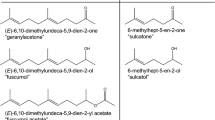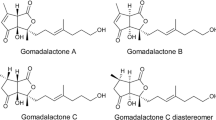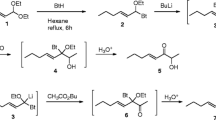Abstract
(R)-(−)-Linalool was identified as a minor component sex pheromone of the scarab beetleHolotrichia parallela (Coleoptera: Scarabaeidae). Field evaluations revealed that, although not attractive per se, (R)-(−)-linalool enhances the attractiveness of the major sex pheromone,L-isoleucine methyl ester (LIME). Analyses of the pheromone titers in the glands of field-collected females demonstrated the occurrence of peak levels of 48-hr (“circabidian”) periodicity. The levels of LIME in the glands of 45-day-old virgin females increased over three times from the scototo the photophase of a calling day, but the amounts of (R)-(−)-linalool did not significantly change. Virgin females had in average two times more LIME and 3.6 times more (R)-(−)-linalool than the average amount found in the field-captured beetles throughout the season.
Similar content being viewed by others
References
Anonymous. 1980. Major insect and other pests of economic plants in Japan. Japan Plant Protection Assoc, Tokyo.
Anonymous. 1987. Major insect and other pests of economic plants in Japan. The Japanese Society of Applied Entomology and Zoology (ed.). Japan Plant Protection Assoc., Tokyo.
Cardé, R.T., andElkinton, J.S. Field trapping with attractants: Methods and interpretation, pp. 111–112,in H.E. Hummel and T.A. Miller (eds.). Techniques in Pheromone Research. Springer-Verlag, New York.
Haynes, K.F., Potter, D.A., andCollins, J.T. 1992. Attraction of male beetle to grubs: Evidence for evolution of a sex pheromone from larval odor.J. Chem. Ecol. 18:1117–1124.
Leal, W.S., Matsuyama, S., Kuwahara, Y., Wakamura, S., andHasegawa, M. 1992a. An amino acid derivative as the sex pheromone of a scarab beetle.Naturwissenschaften 79:184–185.
Leal, W.S., Hasegawa, M., Mochizuki, F., andYasuda, T. 1992b. Behavioral and electrophysiological evidence of sex pheromone(s) inAnomala schonfeldti Ohaus (Coleoptera: Scarabaeidae).Appl, Entomol. Zool. 27:592–594.
Leal, W.S.,Sawada, M., andHasegawa, M. 1993a. The scarab beetleAnomala daimiana utilizes a blend of two otherAnomala spp. sex pheromones.Naturwissenschaften 80: In press.
Leal, W.S., Sawada, M., andHasegawa, M. 1993b. The scarab beetleAnomala cuprea utilizes sex pheromone ofPopillia japonica as a minor component.J. Chem. Ecol. 19:1303–1313.
Tamaki, Y. 1985. Sex pheromones, pp. 145–191,in G.A. Kerkut and L.I. Gilber (eds.). Comprehensive Insect Physiology, Biochemistry and Pharmacology, Vol. 9. Pergamon Press, New York.
Yoshioka, K., andYamasaki, Y. 1983. Ecology ofLachnosterna morosa Waterhouse. I. Behavior of the time of appearance on the ground and oviposition of adult insects.Jpn. J. Appl. Entomol. Zool. 27:52–54.
Author information
Authors and Affiliations
Rights and permissions
About this article
Cite this article
Leal, W.S., Sawada, M., Matsuyama, S. et al. Unusual periodicity of sex pheromone production in the large black chaferHolotrichia parallela . J Chem Ecol 19, 1381–1391 (1993). https://doi.org/10.1007/BF00984883
Received:
Accepted:
Issue Date:
DOI: https://doi.org/10.1007/BF00984883




